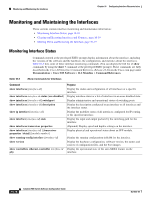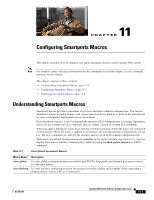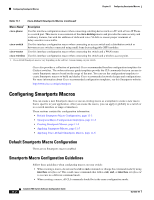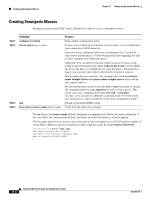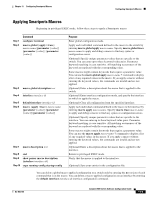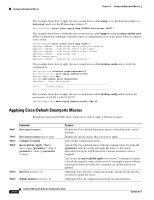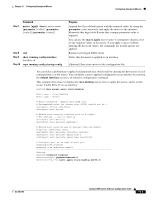Cisco WS-C2960-24TC-S Software Guide - Page 245
macro apply, macro global
 |
View all Cisco WS-C2960-24TC-S manuals
Add to My Manuals
Save this manual to your list of manuals |
Page 245 highlights
Chapter 11 Configuring Smartports Macros Configuring Smartports Macros • When creating a macro that requires the assignment of unique values, use the parameter value keywords to designate values specific to the interface. Keyword matching is case sensitive. All matching occurrences of the keyword are replaced with the corresponding value. Any full match of a keyword, even if it is part of a larger string, is considered a match and is replaced by the corresponding value. • Macro names are case sensitive. For example, the commands macro name Sample-Macro and macro name sample-macro will result in two separate macros. • Some macros might contain keywords that require a parameter value. You can use the macro global apply macro-name ? global configuration command or the macro apply macro-name ? interface configuration command to display a list of any required values in the macro. If you apply a macro without entering the keyword values, the commands are invalid and are not applied. • When a macro is applied globally to a switch or to a switch interface, all existing configuration on the interface is retained. This is helpful when applying an incremental configuration. • If you modify a macro definition by adding or deleting commands, the changes are not reflected on the interface where the original macro was applied. You need to reapply the updated macro on the interface to apply the new or changed commands. • You can use the macro global trace macro-name global configuration command or the macro trace macro-name interface configuration command to apply and debug a macro to find any syntax or configuration errors. If a command fails because of a syntax error or a configuration error, the macro continues to apply the remaining commands. • Some CLI commands are specific to certain interface types. If a macro is applied to an interface that does not accept the configuration, the macro will fail the syntax check or the configuration check, and the switch will return an error message. • Applying a macro to an interface range is the same as applying a macro to a single interface. When you use an interface range, the macro is applied sequentially to each interface within the range. If a macro command fails on one interface, it is still applied to the remaining interfaces. • When you apply a macro to a switch or a switch interface, the macro name is automatically added to the switch or interface. You can display the applied commands and macro names by using the show running-config user EXEC command. There are Cisco-default Smartports macros embedded in the switch software (see Table 11-1). You can display these macros and the commands they contain by using the show parser macro user EXEC command. Follow these guidelines when you apply a Cisco-default Smartports macro on an interface: • Display all macros on the switch by using the show parser macro user EXEC command. Display the contents of a specific macro by using the show parser macro macro-name user EXEC command. • Keywords that begin with $ mean that a unique parameter value is required. Append the Cisco-default macro with the required values by using the parameter value keywords. The Cisco-default macros use the $ character to help identify required keywords. There is no restriction on using the $ character to define keywords when you create a macro. OL-8603-04 Catalyst 2960 Switch Software Configuration Guide 11-3



